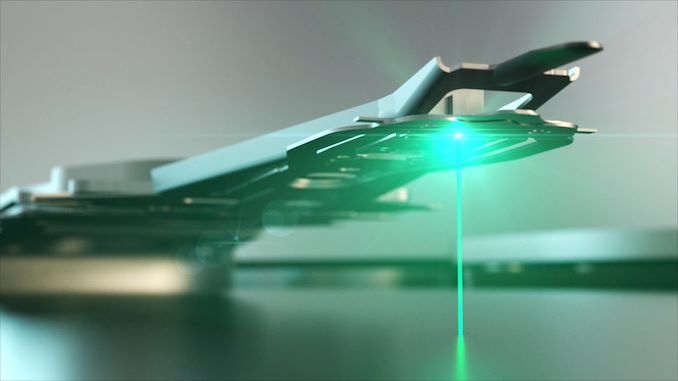Big Leap for Hard Drive Capacities: 32 TB HAMR Drives Due Soon, 40TB on Horizon
by Anton Shilov on June 8, 2023 8:00 AM EST
Offering a brief update on the future of hard drives, Seagate has shared some fresh insights concerning launch of its next generation hard drives featuring its heat-assisted magnetic recording (HAMR) technology. The company's initial commercial HAMR hard drive is set to offer a 32 TB capacity, presumably in the third quarter of 2023, but the new recording technology will enable a relatively quick capacity increase to 40 TB. Meanwhile, high-capacity HAMR HDDs will co-exist with yet-to-be-released 24 TB and 28 TB drives.
The initial 32 TB HAMR-based HDDs from Seagate will rely on the company's 10-platter platform that is akin to that already in use by the company and which has predictable yields and which eliminates one potential point of failure. Given that the company will have to use new media and new write heads with its HAMR hard drives, it is a reasonable move to keep re-using as many proven parts as possible. That 10-platter HAMR platform will be used for 36TB, 40TB, and even higher-capacity HDDs going forward, presumably with as few changes as possible.
"When you go to HAMR, our 32TB is based on 10 disks and 20 heads," said Gianluca Romano, Seagate's chief financial officer, at the Bank of America 2023 Global Technology Conference (via SeekingAlpha). "The following product will be a 36TB and will still be based on 10 disks and 20 heads. So, all the increase is coming through areal density. The following one, 40TB, still the same 10 disks and 20 heads. Also, the 50TB, we said at our earnings release, in our lab, we are already running individual disk at 5TB."
Earlier this year Seagate said that it would 'launch its 30-plus terabyte platform in the June quarter,' so expect these drives to get into hands and racks of hyperscale cloud service providers in the coming months.
Back in April the company said it was shipping HAMR drives inside its Corvault systems for revenue, however, the company refrained from officially disclosing their capacities and only indicated that they were based on the 30 TB+ platform. Meanwhile the company is shipping its HAMR HDDs for qualification to hyperscalers, which will deploy them after they pass their tests.
In anticipation of the full rollout of HAMR drives, some cloud service providers may opt to use Seagate's 24TB HDDs, which rely on its traditional perpendicular magnetic recording (PMR) technology with two dimensional magnetic recording (TDMR) read heads. Additionally, some may even go with 28 TB hard drives that use shingled magnetic recording. Meanwhile, Seagate stresses that these HDDs will be its final high-capacity nearline drives that use perpendicular magnetic recording.
"So, we have a 24TB coming out soon, next few months, you will see it," said Romano. "That is the last PMR product. So I would say [higher] capacity point above 24TB PMR, that is probably 28TB SMR."
Source: Seagate










28 Comments
View All Comments
dontlistentome - Thursday, June 8, 2023 - link
32TB? How many kidneys?goatfajitas - Thursday, June 8, 2023 - link
The good thing is this usually drives down the price of lower models. Hopefully when 32tb drives are out on the high end we can get 16tb drives for $150ish or less.dontlistentome - Thursday, June 8, 2023 - link
I've not seen that for years. Prices seem flat, just the bigger drives come it at higher prices. I paid £110 (about $125) for 8TB drives a decade ago. The thai floods seem to have just put an end to the old gradual cheapening of storage. I'm guessing the main cause is glacial increases in aerial density that have meant it's often been more not denser platters.In the 2TB/3TB/4TB days I used to buy 3 platter drives that would be 50% bigger every couple of years. The bigger drives are now 10 or more platters.
goatfajitas - Thursday, June 8, 2023 - link
Definitely not as fast as it used to, but it still does to a lesser extent. Yeah, that Thai flood thing is still being used as an excuse over a decade later. LOL.sheh - Thursday, June 8, 2023 - link
AFAIK 8TB drives in the consumer space were released only 8.5 years ago, and for around $250 in the US:https://www.engadget.com/2014-12-12-seagate-ships-...
StevoLincolnite - Friday, June 9, 2023 - link
Previously Hard Drives would just increase the amount of bytes per platter through different novel ideas like longitudinal recording to perpendicular to now shingled.But the costs of materials, like the heads have remained static... But these days manufacturers are including more actuators, heads, platters and even gases like Helium to now energy-assisted recording techniques.
So as they have increased in capacities, the cost to manufacture has also increased, whilst market-share has shrunk since SSD's burst onto the scene.
So costs remain static or increased.
Then add supply/demand pressures like floods, covid etc'.
sheh - Friday, June 9, 2023 - link
Price per TB has dropped, although the rate has slowed down.For example (and consumer prices could be cheaper with sale-hunting):
https://www.backblaze.com/blog/wp-content/uploads/...
sheh - Friday, June 9, 2023 - link
Or rather, a longer time span graph:https://www.backblaze.com/blog/wp-content/uploads/...
From here:
https://www.backblaze.com/blog/hard-drive-cost-per...
Renaissance - Sunday, June 11, 2023 - link
HDD volumes have been in decline since peaking in the early 2010s, as much of the industry switches to SSDs. That means the HDD industry no longer has the economies of scale it once did, and HDDs are gradually becoming more specialised, high-end products rather than mainstream consumer ones.lemurbutton - Thursday, June 8, 2023 - link
Genuine question, for those not working at a data center, why do you still need such a large spinning drive?Porn can be streamed. You know?